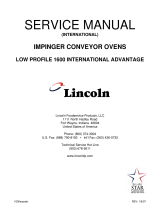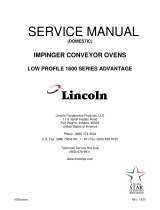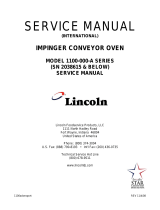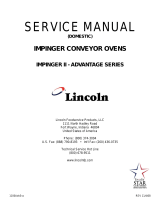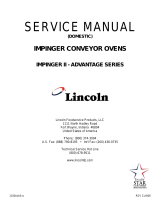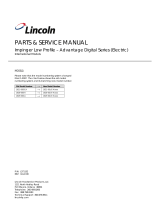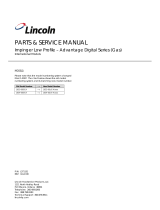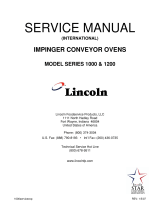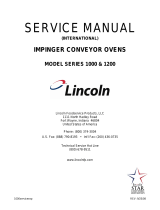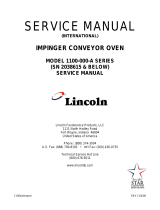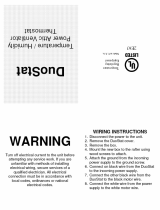
1600SvcMan REV: 12/13/05
SERVICE MANUAL
(DOMESTIC & INTERNATIONAL)
IMPINGER CONVEYOR OVENS
LOW PROFILE - 1600 SERIES
Lincoln Foodservice Products, Inc.
1111 North Hadley Road
P.O. Box 1229
Fort Wayne, Indiana 46801-1229
Phone: (800) 374-3004 • Fax: (260) 436-0735
Technical Service Hot Line
(800) 678-9511
www.lincolnfp.com

Low Profile -–1600 Series Service Manual – Dom & Int’l2
TABLE OF CONTENTS
TABLE OF CONTENTS..............................................................................................................................................2
SEQUENCE OF OPERATIONS 1600 / 1601 / 1652..................................................................................................3
SEQUENCE OF OPERATIONS 1622 / 1623.............................................................................................................4
SEQUENCE OF OPERATIONS / 1628 / 1629...........................................................................................................5
SEQUENCE OF OPERATIONS / 1646, 1647, 1650, 1651........................................................................................7
SCHEMATIC / 1600, 1601, 1652 ...............................................................................................................................9
SCHEMATIC / 1622, 1623........................................................................................................................................10
SCHEMATIC / 1628, 1629........................................................................................................................................11
SCHEMATIC / 1646, 1647, 1650, 1651 ...................................................................................................................12
TROUBLESHOOTING GAS OVENS ......................................................................................................................13
TROUBLESHOOTING / 1622, 1623, 1628, 1629 ...................................................................................................20
TROUBLESHOOTING / 1646, 1647, 1650, 1651 ....................................................................................................26
REMOVAL, INSTALLATION & ADJUSTMENTS .....................................................................................................32
PARTS / GENERAL - 1600 SERIES........................................................................................................................48
BLOW UP / GENERAL – 1600 SERIES...................................................................................................................49
PARTS / CONTROL BOX, RIGHT- 1600 - 1601 - 1652 ..........................................................................................50
BLOW UP / CONTROL BOX RIGHT – 1600, 1601, 1652 .......................................................................................51
PARTS / CONTROL BOX, LEFT - 1600 - 1601 - 1652............................................................................................52
BLOW UP / CONTROL BOX LEFT – 1600, 1601, 1652..........................................................................................53
PARTS / CONTROL BOX, RIGHT –1622,1623,1628,1629.....................................................................................54
BLOW UP / CONTROL BOX RIGHT – 1622,1623,1628,1629 ................................................................................55
PARTS / CONTROL BOX, LEFT 1622,1623,1628,1629 .........................................................................................56
BLOW UP / CONTROL BOX LEFT – 1622, 1623, 1628, 1629................................................................................57
PARTS / CONTROL BOX RIGHT – 1646, 1647, 1650, 1651..................................................................................58
BLOW UP / CONTROL BOX RIGHT – 1646,1647,1650,1651 ................................................................................59
PARTS / CONTROL BOX LEFT – 1646, 1647, 1650, 1651 ....................................................................................60
BLOW UP / CONTROL BOX LEFT – 1646,1647,1650,1651...................................................................................61
PARTS / BACK - 1600 SERIES ...............................................................................................................................62
BLOW UP / BACK – 1600 SERIES..........................................................................................................................63
PARTS / CONVEYOR - 1600 SERIES.....................................................................................................................64
BLOW UP / CONVEYOR – 1600 SERIES ...............................................................................................................65

Low Profile -–1600 Series Service Manual – Dom & Int’l 3
SEQUENCE OF OPERATIONS 1600 / 1601 / 1652
MODEL 1600 / 120 VAC / 60 HZ / NATURAL GAS
MODEL 1601 / 120 VAC / 60 HZ /L.P. GAS
MODEL 1652 / 120 VAC / 60 HZ / TOWN GAS
POWER SUPPLY Electrical power to be supplied to the oven by a three conductor cordset. Voltage from
the black conductor to the white conductor is 120 VAC.
White conductor is Neutral.
Green conductor is Ground.
CONTROL BOX
AUTO COOL DOWN
When the temperature in either one of the Control Boxes reaches 120°F ± 3°F (49°C
± 1.7°C), the Cooling Fan Thermostats will switch power to the Cooling Fans. The
thermostats will interrupt power to the Cooling Fans when the temperature falls to
100°F ± 3°F (37°C ± 1.7°C).
MAIN FAN CIRCUIT 120 VAC is permanently supplied to the normally open contacts of the Oven Power
Relay, to terminal #1 of the 20-Minute Time Delay Module, the normally open
contacts of the Fan Relay and to the (2) normally open Cooling Fan Thermostats.
Closing the normally open Power Switch supplies 120 VAC to the coil of the Oven
Power Relay. These normally open contacts now close, enabling the 20-Minute Time
Delay Module. The 20 Minute Time Delay Module supplies 120 VAC to the Oven Fan
Relay, these normally open contacts now close, supplying 120 VAC, through a 10
Amp fuse, to the (2) Main Fan Motors and, through a 3 Amp fuse, to the (2) Control
Box Cooling Fans.
BURNER CIRCUIT Closing the Oven Power Relay energizes the coil of the Burner Relay. The (2)
normally open contacts now close supplying120 VAC to the (2) burner systems.
NOTE: This oven utilizes (2) complete Burner/Temp. Control Systems. The sequence
of operations is the same for each system.120 VAC is supplied, through the
Centrifugal Switch of the Main Fan Motor (this switch closes when the Main Fan
reaches approximately 1600 R.P.M.) through the 10 Amp Fuse, to the Ignition
Control, the Electronic Temperature Control, and to the Burner Blower Motor. As this
Blower reaches approximately 1600 R.P.M., its internal centrifugal switch will close,
supplying 120 VAC through the cooling fan sail switch to the Burner Transformer.
NOTE: The Cooling Fan Sail Switch is mounted in front of the cooling fan and is
activated by the air flow of the Cooling Fan. The secondary of the Transformer
supplies 24 VAC to the Ignition Control. The Ignition Control operates on both 24 VAC
and 120 VAC. When the control is energized by 24 VAC, 120 VAC is switched to the
Hot Surface Ignitor for 45 seconds for Hot Surface Igniter warm up 24 VAC is now
switched to the Gas Valves which open. Ignitor glows red, and ignition should now
occur. The red Indicator Light is also now energized. If ignition does not occur within 6
seconds, the control will lock out. To retry after lockout, turn off the burner switch, wait
45 seconds, and then turn the switch back on.
TEMPERATURE
CONTROL
When the Centrifugal Switch of the Burner Blower Motor closes, power is applied to
the Temperature Control. The2.5 K ohm Temperature Pot is adjusted to desired
temperature. The thermocouple will provide varying millivolts to theTemperature
Controller. The Temperature Controller supplies 120 VAC to Temperature Regulation
Valve at intermittent intervals to maintain desired temperature.
CONVEYOR DRIVE Closing the Power Switch supplies 120 VAC, through the contact of the Oven Power
Relay, to the primary of the (2) Time/Temp. Transformers. The secondary output of
the Transformers, 12.5 to 15 VAC with a center tap, is supplied to terminals 1, 2, and
3 of the Time/Temp. Display. The Display works on a balanced input, and center tap
voltage to each leg must be 1/2 the total reading.
TIME/TEMP DISPLAY
NOTE
The speed side of the Time/Temp. Display is supplied, by the Conveyor Control, with
the frequency of the pulses to the Conveyor Motor. This frequency is converted by the
Time/ Temp. Display into a read out of minutes and seconds.
The Conveyor Control uses a sensor and magnet, mounted on the Conveyor Motor,
that senses when the motor is turning. If the motor is not turning, the Time/Temp.
Display will show "--:--" in the window.
The temperature portion of the display uses a Thermistor Probe to sense oven
temperature. The Thermistor outputs a resistance proportional to oven temperature.
This resistance is then converted by the Display into a temperature reading.

Low Profile -–1600 Series Service Manual – Dom & Int’l4
OR:
The temperature portion of the display uses a "J" type thermocouple to measure oven
temperature. The thermocouple generates D.C. millivolts proportional to oven
temperature. This millivolt reading is then converted by the display into a temperature
reading.
The oven utilizes (2) Temperature Display systems, one each for the left and right
sides of the cooking chamber.
SEQUENCE OF OPERATIONS 1622 / 1623
MODEL 1622 / 120/208 VAC./.3 PHASE60 HZMODEL
1623 / 120/240 VAC / 3 PHASE. / 60 H
POWER SUPPLY Electrical power to be supplied to the oven by a five conductor service.
Voltage from the black conductor to the white conductor is 120 VAC.
Black conductor is Hot.
Red conductor is Hot.
Orange conductor is Hot.
White conductor is Dedicated Neutral.
Green conductor is Ground.
CONTROL BOX
AUTO COOL DOWN
When the temperature in either one of the Control Boxes reach 120°F± 3°F (49°C±
1.7°C), the Cooling Fan Thermostats will switch power to the Cooling Fans. The
thermostats will interrupt power to the Cooling Fans when the temperature
falls to 100°F± 3°F (37°C ± 1.7°C).
MAIN FAN CIRCUIT Electrical power is permanently supplied through (6)- 50 A. fuses to the normally
open contacts of the mercury contactors. Power is also supplied, through a 10A fuse,
to the Oven Power Switch , through a 3A fuse to a normally open contact of the
Oven Fan Relay, term. # 1 of the 20 minute Time Delay Module and the (2)
normally open Cooling Fan Thermostats. Power is also supplied to a normally open
contact of the the Oven Power Relay. Closing the normally open Oven Power
Switch supplies 120 VAC to the coil of the Oven Power Relay. These normally open
contacts now close, enabling the 20 minute Time Delay Module. The 20 minute
Time Delay Module supplies 120 VAC to the coil of the oven fan relay, these
normally open contacts now close, supplying 120 VAC to the (2) Main Fans and
to the (2) Control Box Cooling Fans.
HEAT CIRCUIT Closing the Oven Power Relay, supplies 120 VAC, through a 3 A fuse, to the (2)
heat systems.
NOTE: This oven utilizes (2) complete Heat/Temp control systems. The sequence of
operations is the same for each system.120 VAC is supplied, through the
Centrifugal Switch of the Main Fan Motor, (This switch closes when the Main Fan
reaches approximately 1600 R.P.M.) through the normally closed High Limit
Thermostat (manually re-settable which opens at 660° F, 350°C) through the
normally open Cooling Fan Sail Switch to the Electronic Temperature Control and
the Heat Indicator Light.
NOTE: The Cooling Fan Sail Switch is mounted in front of the Cooling Fan and is
activated by the air flow of the Cooling Fan.
TEMPERATURE
CONTROL
When the Cooling Fan Sail Switch closes, 120 VAC is supplied to the Temperature
Control. The Temperature Control Potentiometer (2.5K ohm) is adjusted to desired
temperature. The Thermocouple will provide varying millivolts to the Temperature
Controller. TheTemperature Controller supplies 120 VAC to the contactor coil at
intermittent intervals, (closing the Contactor and supplying 208 or 240 VAC to the
Heating Elements) to maintain desired temperature.
CONVEYOR DRIVE Closing the Oven Power Switch supplies 120 VAC, through the contact of the Oven
Power Relay, to the normally open Conveyor Switch. Closing the Conveyor Switch
supplies 120 VAC, through a 3 Amp Fuse, to the primary of the Conveyor Control
Transformer. The secondary of this Transformer supplies 10 VAC and 29 VAC to the

Low Profile -–1600 Series Service Manual – Dom & Int’l 5
Conveyor Control. The Conveyor Control supplies voltage pulses to the Conveyor
Motor. The ConveyorControl Potentiometer varies the frequency of these pulses.
The motor speed will increase or decrease, as the frequency of the pulses increase
or decrease respectively.
TIME/TEMP DISPLAY
Closing the Oven Power Switch supplies 120 VAC, through the contact of the Oven
Power Relay, to the primary of the (2) Time/TempTransformers. The secondary
output of the Transformers, 12.5 to 15 VAC with a center tap, is supplied to
terminals 1, 2, and 3 of the Time/Temp. Display. The display works on a balanced
input, and center tap voltage to each leg must be 1/2 the total reading. The speed
side of the Time/Temp. Display is supplied, by the Conveyor Control, with the
frequency of the pulses to the Conveyor Motor. This frequency is converted by the
Time/Temp. Display into a read out of minutes and seconds.
NOTE: The Conveyor Control uses a Sensor and Magnet, mounted on the Conveyor Motor,
that senses when the motor is turning. If the motor is not turning, the Time/Temp.
Display will show "- - : --" in the window.
The temperature portion of the display uses a Thermistor Probe to sense oven
temperature. The Thermistor outputs a resistance proportional to oven temperature.
This resistance is then converted by the Display into a temperature reading.
OR:
The temperature portion of the display uses a "J" type thermocouple to measure
oven temperature. The thermocouple generates D.C. millivolts proportional to oven
temperature. This millivolt reading is then converted by the display into a
temperature reading. The oven utilizes (2) Temperature Display systems, one each
for the left and right sides of the cooking chamber.
SEQUENCE OF OPERATIONS / 1628 / 1629
MODEL 1628 / 380/220 VAC / 3 PHASE / 50 HZ
MODEL 1629 / 415/240 VAC / 3 PHASE / 50 HZ
POWER SUPPLY
Electrical power to be supplied to the oven by a five conductor service.
Brown conductor is hot.
Black conductor is hot.
Black conductor is hot.
Blue conductor is neutral.
Green/yellow conductor is ground.
CONTROL BOX
AUTO COOL DOWN
When the temperature in either one of the Control Boxes reaches 120°F ± 3°F (49°C
± 1.7°C), the Cooling Fan Thermostats will
switch power to the Cooling Fans. The thermostats will interrupt power to the Cooling
Fans when the temperature falls to 100°F ±
3°F (37°C ± 1.7°C).
MAIN FAN CIRCUIT
Line voltage is permanently supplied through (6) 50 A. fuses, to the normally open mercury
contactors, through a 10A fuse,
to a normally open contact of the Oven Fan Relay, through a 3A fuse to the primary of the control
circuit step down transformer.
(The transformer steps the voltage down to 120 VAC for the control circuit). 120 VAC is permanently
supplied to a normally open contact of the Oven Fan Relay, the (2) normally open cooling fan
thermostats, a normally open contact of the Oven Power Relay,
terminal #1 of the 20 minute Time Delay Module and to the normally open Power Switch. Closing the
Power Switch supplies
120 VAC to the Oven Power Relay, its contacts now close, enabling the 20 minute
Time Delay Module. The 20 -minute Time Delay Module supplies 120 VAC to the
Oven Fan Relay, its contacts now close. supplying line voltage to the (2) Main Fan
Motors and 120 VAC to the (2) cooling fans. 120 VAC is also supplied to the (2)
Time/Temp Transformers, the (2) electronic temperature controls and to the normally

Low Profile -–1600 Series Service Manual – Dom & Int’l6
open Conveyor Switch.
HEAT CIRCUIT
Closing the Oven Power Relay supplies 120 VAC, through a 3A fuse, to the (2) Heat/Temperature
Control systems
NOTE: This oven utilizes (2) complete Heat/Temperature Control systems. The sequence of
operations is the same for both systems,
120 VAC is supplied through a normally open Air Pressure Switch, (closed by air pressure from the
Main Fan),through the normally
closed Hi-limit Thermostat, (manually re-settable opens at 350°C (662°F)) through the Cooling Fan
Sail Switch to the Electronic
Temperature Control Board.
NOTE: The Cooling Fan Sail Switch is mounted in front of the Cooling Fan and is
activated by the air flow of the Cooling Fan
TEMPERATURE
CONTROL
When the Sail Switch closes, power is applied to the Electronic Temperature Control.
The 2.5 K Ohm Temperature Pot. is
adjusted to the desired temperature. The Thermocouple will provide varying millivolts
to the Temperature Controller. The Temperature Controller supplies 120 VAC to the
contactor coil at intermittent intervals (closing the contactor and supplying 220 or 240
VAC to
the heating elements) to maintain desired temperature
CONVEYOR DRIVE Closing the Oven Power Switch supplies 120 VAC, through the contact of the Oven
Power Relay, to the normally open Conveyor Switch. Closing the Conveyor Switch
supplies 120 VAC, through a 3 Amp Fuse, to the primary of the Conveyor Control
Transformer. The secondary of this Transformer supplies 10 VAC and 29 VAC to the
Conveyor Control. The conveyor control supplies voltage pulses to the Conveyor
Motor. The Conveyor Control Potentiometer varies the frequency of these pulses. The
motor speed will increase or decrease, as the frequency of the pulses increase or
decrease respectively.
TIME/TEMP DISPLAY Closing the Oven Power Switch supplies 120 VAC to the primaries of the (2)
Time/Temp. Transformers. The secondary output of the Transformers, 12.5 to 15
VAC with a center tap, is supplied to terminals 1, 2, and 3 of the Time/Temp. Display.
The Display works on a balanced input, and center tap voltage to each leg must be
1/2 the total reading. The speed side of the Time/Temp. Display is supplied, by the
Conveyor Control, with the frequency of the pulses to the Conveyor Motor. These
pulses are converted by the Time/Temp. Display into a read out of minutes and
seconds.
NOTE: The Conveyor Control uses a sensor and magnet, mounted on the Conveyor Motor,
that senses when the motor is turning. If
the motor is not turning, the Time/Temp. Display will show"--:--" in the window.
The temperature portion of the display uses a Thermistor Probe to sense oven
temperature. The Thermistor outputs a resistance proportional to oven temperature.
This resistance is then converted by the Display into a temperature reading.
OR:
The temperature portion of the display uses a "J" type thermocouple to measure oven
temperature. The thermocouple generates D.C. millivolts proportional to oven
temperature. This millivolt reading is then converted by the display into a temperature
reading.
The oven utilizes (2) Temperature Display systems, one each for the left and right
sides of the cooking chamber.

Low Profile -–1600 Series Service Manual – Dom & Int’l 7
SEQUENCE OF OPERATIONS / 1646, 1647, 1650, 1651
MODEL 1646 / 220-240 VAC / 50 HZ / NATURAL GAS
MODEL 1647 / 220-240 VAC / 50 HZ / L.P. GAS
MODEL 1650 / 220-240 VAC / 50 HZ / TOWN GAS
MODEL 1651 / 220-240 VAC / 50 HZ / TOWN GAS
POWER SUPPLY Electrical power to be supplied to the oven by a three conductor service.
Brown conductor is hot.
Blue conductor is neutral.
Green conductor is ground.
CONTROL BOX AUTO COOL AUTO
COOL DOWN
When the temperature in either one of the Control Boxes reaches 120°F ± 3°F (49°C
± 1.7°C), the Cooling Fan Thermostats will switch power to the Cooling Fans. The
thermostats will interrupt power to the Cooling Fans when the temperature falls to
100°F ± 3°F (37°C ± 1.7°C).
MAIN FAN CIRCUIT Line voltage is permanently supplied to a normally open contact of the oven power
switch, through a 10A fuse to the normally open oven fan relay, and through a 3A
fuse to the primary of the control circuit step down transformer (The transformer steps
the voltage down to 120 VAC for the control circuit). 120 VAC is permanently supplied
to the (2) normally open cooling fan thermostats, a normally open contact of the cool
down relay, terminal #1 of the 20 -minute time delay module and to the normally open
oven power switch. Closing the oven power switch supplies 120 VAC to the cool-
down relay, its contacts now close, supplying 120 VAC to the (2) cooling fans. and
enabling the 20 minute time delay module. The 20-minute time delay module supplies
120 VAC to the oven fan relay, its contact now closes supplying line voltage to the (2)
main fan motors. 120 VAC is also supplied to the (2) time/temp transformers, the
conveyor switch and the (2) electronic temperature controls.
BURNER CIRCUIT NOTE: This oven utilizes (2) complete Burner/Temp. Control Systems. The sequence
of operations is the same for each system. Closing the normally open oven power
switch supplies line voltage through a 3A fuse, through the sail switch, through the
gas pressure switch, through the Main Fan Air Pressure Switch, through the Hi-limit
Thermostat, to the Ignition Control. The combustion motor is energized. The normally
open combustion air switch closes upon sensing air pressure. After a pre-purge
period of between 30 and 60 seconds, the Ignition Transformer and the Main Gas
Valve are energized. Ignition should now occur.
NOTE: The Cooling Fan Sail Switch is mounted in front of the cooling fan and is
activated by the air flow of the Cooling Fan.
TEMPERATURE
CONTROL
Closing the Oven Power Switch supplies 120 VAC (through the Step Down
Transformer) to the Temperature Control Board. The 2.5k ohm Temperature Pot is
adjusted to desired temperature. The Thermocouple will provide varying millivolts to
the Temperature Controller. The Temperature Controller supplies 120 VAC to the
Solenoid Valve at intermittent intervals to maintain desired temperature.
CONVEYOR DRIVE Closing the Oven Power Switch supplies 120 VAC, through the contact of the Oven
Power Relay, to the normally open Conveyor Switch. Closing the Conveyor Switch
supplies 120 VAC, through a 3 Amp Fuse, to the primary of the Conveyor Control
Transformer. The secondary of this Transformer supplies 10 VAC and 29 VAC to the
Conveyor Control. The conveyor control supplies voltage pulses to the Conveyor
Motor. The Conveyor Control Potentiometer varies the frequency of these pulses. The
motor speed will increase or decrease, as the frequency of the pulses increase or
decrease respectively.
TIME/TEMP DISPLAY Closing the Oven Power Switch supplies 120 VAC, through the contact of the Oven
Power Relay, to the primary of the (2)Time/Temp. Transformers. The secondary
output of the Transformers, 12.5 to 15 VAC with a center tap, is supplied to terminals
1, 2, and 3 of the Time/Temp. Display. The Display works on a balanced input, and
center tap voltage to each leg must be 1/2 the total reading. The speed side of the
Time/Temp. Display is supplied, by the Conveyor Control, with the frequency of the
pulses to the Conveyor Motor. These pulses are converted by the Time/Temp.
Display into a read out of minutes and seconds.
NOTE:
The Conveyor Control uses a sensor and magnet, mounted on the Conveyor Motor,
that senses when the motor is turning. If the motor is not turning, the Time/Temp.
Display will show "--:--" in the window. The temperature portion of the display uses a

Low Profile -–1600 Series Service Manual – Dom & Int’l8
Thermistor Probe to sense oven temperature. The Thermistor outputs a resistance
proportional to oven temperature. This resistance is then converted by the Display
into a temperature reading.
OR:
The temperature portion of the display uses a "J" type thermocouple to measure oven
temperature. The thermocouple generates D.C. millivolts proportional to oven
temperature. This millivolt reading is then converted by the display into a temperature
reading.
The oven utilizes (2) Temperature Display systems, one each for the left and right
sides of the cooking chamber.

Low Profile -–1600 Series Service Manual – Dom & Int’l 9
SCHEMATIC / 1600, 1601, 1652

Low Profile -–1600 Series Service Manual – Dom & Int’l10
SCHEMATIC / 1622, 1623

Low Profile -–1600 Series Service Manual – Dom & Int’l 11
SCHEMATIC / 1628, 1629

Low Profile -–1600 Series Service Manual – Dom & Int’l12
SCHEMATIC / 1646, 1647, 1650, 1651

Low Profile -–1600 Series Service Manual – Dom & Int’l 13
TROUBLESHOOTING GAS OVENS
MODEL 1600, 1601, 1652
1600-000-DB, 1601-000-DB
NOTE: When checking components on left side of unit, be sure to check wire harness across back of
oven for proper connections in power connector, (marked P. C. on Schematic Diagram, inside control
box cover).
SYMPTOM POSSIBLE CAUSE EVALUATION
Incoming Power Supply Check breakers/Reset if required/ Call Power
Company if needed.
Power Switch Check continuity between switch terminals.
Oven Power Relay Check for 120 VAC to the relay coil. If voltage is not
present, trace wiring back to the fan switch. If voltage
is present, check to insure contacts are closing.
Check for 120 VAC supplied t terminal #2 of the relay.
20 Minute Time Delay Check for 120 VAC at terminal #1 to neutral on the 20
minute timer. If no voltage is present, trace wiring
back to the power supply. If voltage is present at
terminal #1, check for 120 VAC at terminal #2 to
neutral. If no voltage is present, and the oven power
relay is closed, replace the 20 minute timer.
Oven Fan Relay Check for 120 VAC to coil of the oven fan relay. If no
voltage is present, trace wiring back to terminal #2 of
the 20minute timer. Check for 120 VAC at terminals
#2 and #6 of the relay, if no voltage is present, trace
wiring back to the power supply. If voltage is present
at the relay coil, check to insure the contacts are
closing.
Fuse, Fan, 10A Check, replace if necessary.
Fuseholder Check, replace if necessary
Capacitor(s) Check for opens, shorts, or grounds.
Oven fan(s) will not run
Motor(s)
Check for opens, shorts, or grounds. WITH POWER OFF:
turn the fan blade(s) to check for locked rotor.
20 Minute Time Delay Check for 120 VAC at terminal #2 to neutral while
oven is "on". Turn off the main fan switch, 120 VAC
should continue to be present for 20 minutes. If
voltage is not present for approx. 20 minutes, replace
the timer.
No main fan cool down
Oven Fan Relay Check if relay is operating and that the contacts
remain closed during the 20 minute cool down.
Oven Power Relay Contacts should open when main fan switch is turned
off.
20 Minute Time Delay 120 VAC at terminal #2 should discontinue
approximately 20 minutes after main fan is switched
off. If the oven power relay contacts are open, and the
voltage continues at terminal #2 of the 20 minute
timer, for more than 20 mins., replace the timer.
Main fan runs after20
minute cool down
Oven Fan Relay Check to insure that the contacts are opening after the
coil is de-energized.
Power Switch
Oven Power Relay
20 Minute Time Delay
Oven Fan Relay
(SEE MAIN FAN WILL NOT RUN)
Fuse, Cooling Fans (3A) Check, replace if necessary.
No control box cooling
Fuseholder Check, replace if necessary
Cooling Fan(s) 120 VAC should now be at these motors. If voltage is
present, check motor(s) for shorts, opens, or grounds
WITH POWER OFF: check for locked rotor.

Low Profile -–1600 Series Service Manual – Dom & Int’l14
Incoming Power Supply Check circuit breakers, reset if required. Call the
Power Company if needed.
Cooling Fan Thermostat(s) Check the cooling fan thermostat. (Thermostat closes
at 120°F and opens at 100°F.) With the cooling fan
thermostat pre-heated, check for continuity. If switch
is open, replace.
No automatic control
box cooling
Fuse, Cooling Fans (3A)
Fuseholder
Cooling Fan(s)
Check, replace if necessary.
Check, replace if necessary.
120 VAC should now be at these motors. If voltage is
present, check motor(s) for shorts, opens, or grounds.
WITH POWER OFF: check for locked rotor .
Cooling Fan Thermostat(s) Thermostat is normally open and may have closed if
control box temperature is 120°F or above.
Cooling fans continue
to run after 20 minute
cool down
Oven Fan Relay Check to insure contacts are opening after the 20
minute cool down.
Gas Supply Check for adequate gas supply and closed manual
gas shut-off.
Main Fan(s) If not operating, refer to "Oven fan will not run." Page
13 “
Oven will not heat
Burner relay 120 VAC should be present at the coil of burner relay.
If voltage is not present, trace wiring back to the oven
power relay and back to power supply if needed. If
voltage is present, check to insure the relay contacts
are closing. Replace as necessary
.
NOTE: These ovens utilize 2 complete Burner/Temperature control systems. Each system will
follow the same Troubleshooting Sequence.
Centrifugal Switch of Main Fan Motor
Check for 120 VAC supplied to the centrifugal switch, if
voltage is not present, trace the wiring back to the
burner relay. Check for 120 VAC out of the centrifugal
switch. If voltage is supplied to the centrifugal switch,
and motor is running, but there is no voltage out of the
centrifugal switch, replace the fan motor.
(NOTE: see Schematic Diagram for proper wire
numbers on motors)
Fuse, Burner 10A Check, replace if necessary.
Fuseholder Check, replace if necessary.
Burner Blower Motor
Check for 120 VAC supply to the burner blower motor, if 120 VAC is
present and motor does not run, replace the motor.
WITH POWER OFF: turn blower wheel to check for
locked rotor.
Centrifugal Switch of Burner
Blower Motor
Check for 120 VAC supply to the centrifugal switch of
burner blower motor (see Schematic for proper wire
numbers). If no voltage is present, trace wiring back to
the fuseholder. If voltage is present, check for 120 VAC
at the output of the centrifugal switch. If there is no
output, and the burner blower motor is running, replace
the burner blower motor.

Low Profile -–1600 Series Service Manual – Dom & Int’l 15
Control Box Cooling Fan Check to insure the control box cooling fan is operating
properly. If the cooling fan is not operating, refer to "No
control box cooling" Page 14”.
Cooling Fan Sail Switch (NOTE: the cooling fan sail switch is located in front of
the cooling fan and is activated by the air flow from the
cooling fan.) Check for 120 VAC supply to the sail
switch (see Schematic for proper wire numbers).
Visually check to see the sail switch is closing as
cooling fan is running, if the sail switch is not closing,
check for obstructions or damage to the sail switch. If
the sail switch is closing, check for 120 VAC out of the
sail switch. If there is no voltage, and the sail switch is
closed, replace the sail switch.
Burner Transformer Check for 120 VAC to primary of the 24 VAC burner
transformer. If voltage is not present, trace wiring back
to the sail switch. If voltage is present, check for 24
VAC at the secondary, if no secondary voltage is
present, replace the transformer.
Ignition Control Check for 24 VAC supply to the ignition control at
terminals marked 24V and 24Vgnd. If voltage is not
present, trace wiring back to the 24 VAC transformer.
Check for 120 VAC supply to the ignition control at
terminals L1 and L2. If no voltage is present, trace
wiring back to terminal #11 on the temperature control.
If the above checks are okay, proceed. The ignition
control should switch 120 VAC to the hot surface
igniter, across the (2) terminals marked HSI. If no
voltage is present, replace ignition control.
Hot Surface Igniter(located
inside Burner Assy.)
If 120 VAC is present at HSI terminals, visually check
to see that the hot surface igniter is heating (igniter
may be viewed through port glass in end of burner
tube). The igniter should glow bright red. Check all
connections to be sure they are tight. If the igniter does
not heat, replace.
Ignition Control After 45 seconds of hot surface igniter pre-heat, the
ignition control will switch 24 VAC to the gas control
valves. Check for 24 VAC output from the ignition
control, and across terminals marked "valve" and
"valve gnd". If no voltage is present, replace the ignition
control. NOTE: the ignition control contains a safety
lock-out circuit. If a flame is not detected within 6
seconds after the gas control valve is energized, the
ignition control will lock-out. To reset, turn the burner
switch "off", wait 45 seconds and switch the burner
system "on" to retry ignition
Gas Control Valves Check for 24 VAC supplied to the gas control valves. If
voltage is present, the valves should open. Check for
gas pressure at the pressure tap, located in the gas
piping just prior to the burner. If there is no gas
pressure, and the voltage is supplied to valves, check
piping for obstructions. If there are no obstructions,
replace gas control valves. NOTE: the red burner
indicator light is wired in parallel with the gas control
valves. When 24 VAC is supplied to the gas control
valves the red burner indicator light is also energized.

Low Profile -–1600 Series Service Manual – Dom & Int’l16
Hot Surface Igniter The ignition control will keep the gas control valves
energized for 6 seconds. At the end of 6 seconds, the
hot surface igniter must sense a flame, or, the ignition
control will go into lock- out. (The ignition control
requires a minimum of 0.8 microamps D.C.) To check
the flame sensing operation, connect a digital
multimeter (capable of measuring D.C. micro-amps)
between the "ground" terminal on ignition control and
the ground lead.
NOTE: This is a current measurement and the meter
must be connected in series. If these readings are not
achieved, check bypass orifice for obstructions, if
bypass orifice is clear, replace the hot surface igniter.
NOTE: The D.C. micro amp test must be conducted
with the oven in low flame (bypass) operation. Turn the
temperature control to its lowest setting
Power Supply If there is sufficient micro-amp current, but the flame
will not stay lit, check for proper polarity of the 120 VAC
power supply
Flame will not stay lit
Ignition Control If there is sufficient micro-amp current, and the 120
VAC polarity is correct, but the flame will not stay lit,
replace the ignition control.
NOTE: Check for proper ground connection of the
ignition control.
NOTE: Flame should be
present at this time
Check for 120 VAC supply at terminal #11 to neutral on
the temperature control. If no voltage is present, trace
the wiring back to 10 A fuse. Turn the temperature
adjustment knob to its maximum temperature position
and check for 120 VAC at the load terminal (#9) and
neutral. If 120 VAC is present and unit is not heating,
refer to "Temperature Regulation Valve" for next check.
If 120 VAC is not present, proceed.
Thermocouple Probe WITH POWER ON AND THERMOCOUPLE LEADS
ATTACHED TO THE TEMPERATURE CONTROL
BOARD: measure the D. C. millivolt output of these
leads. Refer to the thermocouple chart page 43 for
proper readings. If these readings are not achieved,
replace the thermocouple.
Temperature Control
Potentiometer
WITH POWER OFF: remove the potentiometer leads
from the temperature control board and measure ohms
from black to white leads. The reading should be from
0 to 2.5k ohms ± 10% as the dial of the potentiometer
is turned throughout its full rotation. From black to red
leads, the reading should be 2.5k ohms ± 10%
(constant) throughout the full rotation of the dial. If
these readings are not achieved, replace the
potentiometer. If the thermocouple probe and the
control potentiometer check good, then the problem is
usually with the temperature control board.
Low flame is on, but
no main flame.
Temperature Regulation
Valve
If 120 VAC is present on the temperature control board
at load terminal (#9) to neutral, check for voltage at the
temperature regulation valve. If voltage is present,
listen for the valve to open and close. Also check for
opens or shorts inthe coil. Replace as necessary.

Low Profile -–1600 Series Service Manual – Dom & Int’l 17
Intermittent Heating Thermal/Overload The main fan motors, burner blower motors, and
cooling fan motors are equipped with internal thermal
protection and will cease to operate if overheating
occurs. As the motors overheat and then cool, this will
cause the units to cycle on and off intermittently.
Improper ventilation or preventive maintenance may
cause this. Also, most of the problems listed under
"Oven will not heat" on Page 14 can cause intermittent
failure.
NOTE: The 1600-000-DB series ovens utilize 2 complete conveyor drive systems.
Conveyor Switch Check for 120 VAC to conveyor switch. If no voltage
is present, trace wiring back to the oven fan switch.
WITH POWER OFF: Check continuity between
switch terminals.
Conveyor Fuse (3A) Check, replace if necessary.
Fuseholder Check, replace if necessary.
Conveyor Control
(Stepper) Transformer
Check for 120 VAC supply to primary of transformer,
if voltage is not present, trace wiring back to the
fuseholder. If voltage is present check for output
voltage from the transformer secondary
NOTE: this control transformer outputs (2) secondary
voltages
Red Leads 29 VAC
Brown Leads 10 VAC
If BOTH secondary voltages are not present, replace
the transformer.
Speed Adjustment
Potentiometer
This is a 0 to 50k ohm, 10 turn Brown Leads 10 VAC
potentiometer.
WITH POWER OFF: remove the 3 pin potentiometer
cable plug from the motor control board. With a
digital multimeter, check the ohm reading across the
red lead to the black lead, this reading should be 50k
ohms ± 5% as the potentiometer is rotated through
its 10 turn rotation. Place the meter leads on the red
lead and white lead. Rotating the potentiometer
slowly, from low to high, the meter should show an
even transition from 0 to 50k ohms ± 5% through the
10 turn rotation of the potentiometer. There should
be no dead or open spots through the 10 turns of the
potentiometer. Check all three leads to ground.
There should be no continuity to ground. If any of the
above checks fail, replace the potentiometer.
Conveyor Motor
(Stepper) Control
NOTE: if the conveyor drive motor becomes jammed
or begins to run at an uncontrolled speed, the
conveyor motor will stop running. To reset, turn off
the conveyor switch, wait 30 seconds, turn the
conveyor switch on. If the motor does not run after
attempting re-set, check for 2 to 29 VAC across the
motor terminals 1 to 2 and 3 to 5 on the conveyor
motor control. If voltage is not present at both sets of
terminals, replace control.
Conveyor will not run
Conveyor Drive(Stepper)
Motor
Check the drive sprocket on motor output shaft to
insure that it is tight. Check motor windings;
measurements should be approximately 2 ohms.
Terminal 1-5, 2-6, 3-7, 4-8.
WITH POWER OFF: Turn the motor shaft to check
for jammed gear box. If motor shaft will not turn,
replace conveyor drive (stepper) motor.

Low Profile -–1600 Series Service Manual – Dom & Int’l18
12 VAC Power
Supply(Transformer)
Measure the transformer primary for a nominal 120
VAC input, if voltage is not present, trace wiring back
to the power supply. Measure the secondary output,
which will normally be 12-15 VAC. Voltage across
terminals 1 and 3 on the time/temp. display should
read 12-15 VAC. Terminals 1-2 and 2-3 should be
1/2 the voltage reading 1 to 3. If the above secondary
readings are not achieved, replace transformer.
Time/Temp. Display
inoperative
NOTE: these units utilize
(2) complete temperature
display systems containing
like components.
Time/Temp. Display If proper voltage is present at terminals 1, 2, and 3
on time/temp. display, but the display is not lighted,
recheck all connections for tightness. If time/temp.
display is still not operating, replace the time/temp.
display
NOTE: Time/Temp
displays uses two types
of temperature sensor,
Thermistor Probe2 yellow
wires, Thermo- couple
Probe 1 red wire and 1
white wire
Connect the thermocouple of a pyrometer to the
thermocouple on the temperature control board. (Be
sure to maintain proper polarity of thermocouple
leads- see Adjustment Section for proper
procedure .) The pyrometer will now indicate oven
temperature
Thermistor Probe Disconnect the yellow tipped thermistor leads from
the time/temp. terminals 9 and 10. Measure the
resistance of the thermistor probe. See chart on page
43 for proper resistance readings. Inspect the
thermistor bulb for its proper location in its spring
holder. Check for short in leads where they enter the
sensor bulb. Also check each thermistor lead for
short to ground.
Thermocouple Probe Measure D.C. millivolts at terminals 9 and 10 on the
time/temp display. See thermocouple chart on page
43 for proper readings. Replace thermocouple if
proper readings are not achieved. If readings are
correct on the thermocouple, replace time/temp
display.
Temp. display out or
erratic
Power Supply If a strange or unusual behavior is experienced, such
as a rolling of numbers, or lock-up at a given number,
first check for a display circuit lock-up. A voltage
spike or surge in the incoming power lines may
cause this. To eliminate this condition, remove power
from the time/temp. display by shutting off the main
fan switch for 15 seconds. This should eliminate the
problem. If this does not solve the problem, it may be
coming in through the Commercial power lines.
Suggest that customer contact their power company
for evaluation.
Temp. display
inaccurate, erratic,
or inoperative
Time/Temp. Display Perform the power supply check, the thermistor
probe check, and then perform the time/temp.
simulator test. Refer to page 36 & 37 for instructions.
Remember, when using the time/temp. simulator,
remove all leads from the back of the time/temp.
display except the 3 power leads. After completion of
the test, and if re-installing time/temp. display back in
the oven, the dip switches must be reset for oven
operation, and the time/temp. display must be
recalibrated. If readings are not achieved, replace
display.

Low Profile -–1600 Series Service Manual – Dom & Int’l 19
Perform all checks as in the above evaluation. If the
time check is okay, refer to the next section.
Conveyor Drive
(Stepper) Motor
Check to see if the conveyor drive (stepper) motor is
running. If motor is not running, refer to "Conveyor
will not run" on Page 23.
Magnet Check to insure that the magnet (cemented to shaft
of conveyor drive [stepper] motor) has not been
damaged, or come loose from motor shaft. Replace
as needed.
Hall Effect Sensor Check for any physical damage to Hall Effect sensor
(mounted on conveyor drive [stepper] motor). Check
all wiring and connections for damage.
Time Display inaccurate,
erratic, or inoperative
Conveyor Drive
(Stepper) Control
Check all connections for tightness or proper location
and check all wiring for visible damage. Replace as
needed. If there is still no time display, wire in
(temporarily) a new conveyor drive control. If there is
still no time display, reconnect original conveyor drive
control. Replace Hall Effect Sensor.

Low Profile -–1600 Series Service Manual – Dom & Int’l20
TROUBLESHOOTING / 1622, 1623, 1628, 1629
ELECTRIC OVENS
NOTE: When checking components on left side of unit, be sure to check wire harness across back of
oven for proper connections in power connectors, (marked P.C. on Schematic Diagram, located inside
motor cover).
SYMPTOM POSSIBLE CAUSE EVALUATION
Incoming Power Supply Check breakers/Reset if required/ Call Power
Company if needed.
Fuse, Main Fan 10A Check, replace if necessary.
Fuseholder Check, replace if necessary.
Fuse, Transformer 3A 1628 Check, replace if necessary
Fuseholder 1629 Check, replace if necessary
Transformer Power Only 120 VAC +_10% should be present at secondary of
transformer. If proper voltage is not present, check
transformer primary for proper input.
Power Switch Check for 120 VAC to switch Check continuity
between switch terminals.
Oven Power Relay Check for 120 VAC to the relay coil. If voltage is not
present, trace wiring back to the oven power switch.
If voltage is present, check to insure contacts are
closing. Check for 120 VAC supplied to terminal #2
of the relay. If power is not present, trace wiring
back to transformer.
20 Minute Time Delay Check for 120 VAC at terminal #1 to neutral on the
20-minute timer. If no voltage is present, trace wiring
back to the power supply. If voltage is present at
terminal #1, check for 120 VAC at terminal #2 to
neutral. If no voltage is present, and the oven power
relay is closed, replace the 20-minute timer.
Oven Fan Relay Check for 120 VAC to coil of the oven fan relay. If no
voltage is present, trace wiring back to terminal #2
of the 20 minute timer. Check for 120 VAC at
terminal #2 and supply voltage at #6 of the relay, if
no voltage is present, trace wiring back to the power
supply. If voltage is present at the relay coil, check
to insure the contacts are closing.
Capacitor(s) Motor(s) Check for opens, shorts, or grounds.
WITH POWER OFF: turn the fan blade(s) to check
for locked rotor.
20 Minute Time Delay Check for 120 VAC at terminal #2 to neutral while
oven is "on". Turn off the power switch, 120 VAC
should continue to be present for approx.20
minutes. If voltage is not present for approx. 20
minutes, replace the timer.
Oven fan(s) will not
run
Oven Fan Relay Check if relay is operating and that the contacts
remain closed during the 20 minute cool down.
Oven Power Relay Contacts should open when power switch is turned
off and coil is de-energized.
20 Minute Time Delay 120 VAC at terminal #2 should discontinue
approximately 20 minutes after main fan is switched
off. If the oven power relay contacts are open, and
the voltage continues at terminal #2 of the 20 minute
timer, replace the timer.
Oven Fan Relay Check to insure that the contacts are opening after
the coil is de-energized.
Main fan runs after20
minute cool down
Fuse, Transformer 3A Check, replace if necessary.
Fuseholder 1628 Check, replace if necessary.
Page is loading ...
Page is loading ...
Page is loading ...
Page is loading ...
Page is loading ...
Page is loading ...
Page is loading ...
Page is loading ...
Page is loading ...
Page is loading ...
Page is loading ...
Page is loading ...
Page is loading ...
Page is loading ...
Page is loading ...
Page is loading ...
Page is loading ...
Page is loading ...
Page is loading ...
Page is loading ...
Page is loading ...
Page is loading ...
Page is loading ...
Page is loading ...
Page is loading ...
Page is loading ...
Page is loading ...
Page is loading ...
Page is loading ...
Page is loading ...
Page is loading ...
Page is loading ...
Page is loading ...
Page is loading ...
Page is loading ...
Page is loading ...
Page is loading ...
Page is loading ...
Page is loading ...
Page is loading ...
Page is loading ...
Page is loading ...
Page is loading ...
Page is loading ...
Page is loading ...
Page is loading ...
Page is loading ...
Page is loading ...
/
